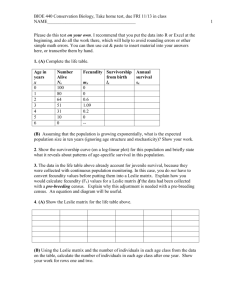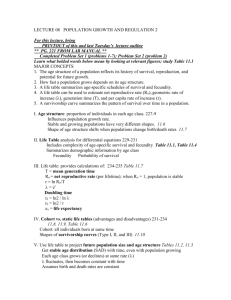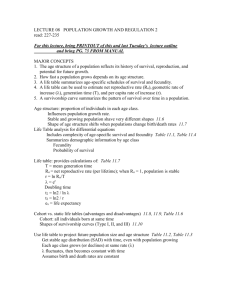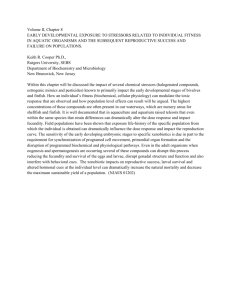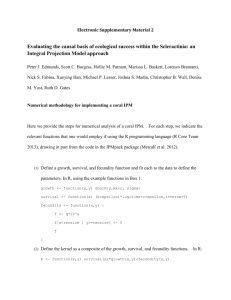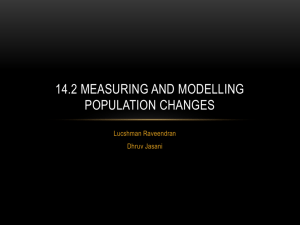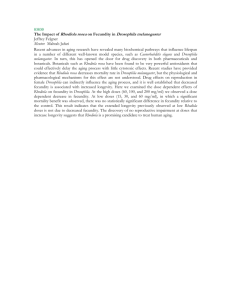Document 10465784
advertisement
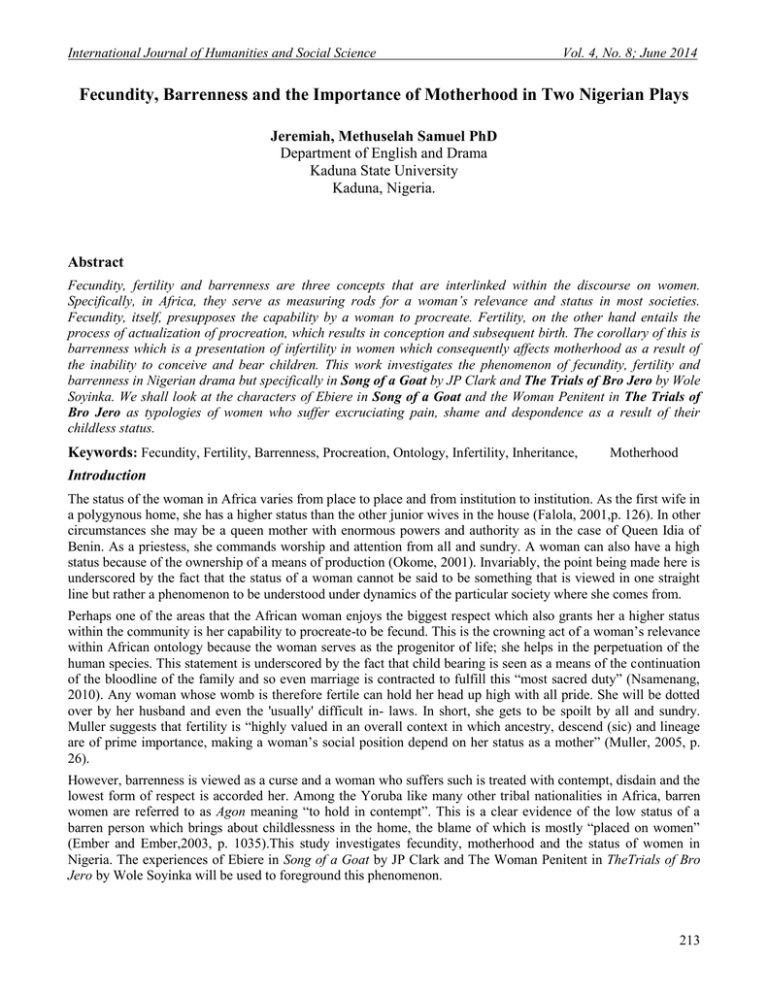
International Journal of Humanities and Social Science Vol. 4, No. 8; June 2014 Fecundity, Barrenness and the Importance of Motherhood in Two Nigerian Plays Jeremiah, Methuselah Samuel PhD Department of English and Drama Kaduna State University Kaduna, Nigeria. Abstract Fecundity, fertility and barrenness are three concepts that are interlinked within the discourse on women. Specifically, in Africa, they serve as measuring rods for a woman’s relevance and status in most societies. Fecundity, itself, presupposes the capability by a woman to procreate. Fertility, on the other hand entails the process of actualization of procreation, which results in conception and subsequent birth. The corollary of this is barrenness which is a presentation of infertility in women which consequently affects motherhood as a result of the inability to conceive and bear children. This work investigates the phenomenon of fecundity, fertility and barrenness in Nigerian drama but specifically in Song of a Goat by JP Clark and The Trials of Bro Jero by Wole Soyinka. We shall look at the characters of Ebiere in Song of a Goat and the Woman Penitent in The Trials of Bro Jero as typologies of women who suffer excruciating pain, shame and despondence as a result of their childless status. Keywords: Fecundity, Fertility, Barrenness, Procreation, Ontology, Infertility, Inheritance, Motherhood Introduction The status of the woman in Africa varies from place to place and from institution to institution. As the first wife in a polygynous home, she has a higher status than the other junior wives in the house (Falola, 2001,p. 126). In other circumstances she may be a queen mother with enormous powers and authority as in the case of Queen Idia of Benin. As a priestess, she commands worship and attention from all and sundry. A woman can also have a high status because of the ownership of a means of production (Okome, 2001). Invariably, the point being made here is underscored by the fact that the status of a woman cannot be said to be something that is viewed in one straight line but rather a phenomenon to be understood under dynamics of the particular society where she comes from. Perhaps one of the areas that the African woman enjoys the biggest respect which also grants her a higher status within the community is her capability to procreate-to be fecund. This is the crowning act of a woman’s relevance within African ontology because the woman serves as the progenitor of life; she helps in the perpetuation of the human species. This statement is underscored by the fact that child bearing is seen as a means of the continuation of the bloodline of the family and so even marriage is contracted to fulfill this “most sacred duty” (Nsamenang, 2010). Any woman whose womb is therefore fertile can hold her head up high with all pride. She will be dotted over by her husband and even the 'usually' difficult in- laws. In short, she gets to be spoilt by all and sundry. Muller suggests that fertility is “highly valued in an overall context in which ancestry, descend (sic) and lineage are of prime importance, making a woman’s social position depend on her status as a mother” (Muller, 2005, p. 26). However, barrenness is viewed as a curse and a woman who suffers such is treated with contempt, disdain and the lowest form of respect is accorded her. Among the Yoruba like many other tribal nationalities in Africa, barren women are referred to as Agon meaning “to hold in contempt”. This is a clear evidence of the low status of a barren person which brings about childlessness in the home, the blame of which is mostly “placed on women” (Ember and Ember,2003, p. 1035).This study investigates fecundity, motherhood and the status of women in Nigeria. The experiences of Ebiere in Song of a Goat by JP Clark and The Woman Penitent in TheTrials of Bro Jero by Wole Soyinka will be used to foreground this phenomenon. 213 © Center for Promoting Ideas, USA www.ijhssnet.com Conceptual Clarifications: Fecundity, Fertility, Barrenness Fecundity is defined as “the quality of being fruitful, either in regard to offspring or in regard to vegetation... Survival of any species depends on the production of viable offspring. Fecundity is an important trait for all living things” (http://www.wisegeek.com/in-biology-what-is-fecundity.htm). In the biological sciences, a fecund plant has the ability to not only produce seeds but also the mechanism to transport these seeds to a given area through carriers like birds, wind or water where they either cross- pollinate or self pollinate. Animals are also considered fecund when they possess the ability to release thousands of eggs with just a few getting fertilized to develop to adult species. Within the ambit of demographic analysis, fecundity is conceived as “the demonstrated capability to bear children, it implies the condition necessary for conception in women of whom its variations are predicted (Duncan as quoted in Cole, 2000, p. 190). Singh (2007) simply refers to it as “the biological capacity of a woman to reproduce” (p. 280). She possesses this capacity as long as she produces eggs which are healthy and can be fertilized which among humans, serves to ensure the perpetuation of life. (http://www.wisegeek.com/in-biologywhat-is-fecundity.htm). Closely related to this term is the word fertility. In many occasions, people have used fertility and fecundity to mean the same. However, a line of distinction separates them. Fertility by definition refers to actual births, while fecundity refers to the biological ability to have children. In short, “fertility implies fecundity and also introduces the idea of number of progeny; while fecundity simply indicates quality without superadded notion of quantity” (Singh, 2007, p. 280). It can be suggested therefore that in the process of reproduction, a woman can be fecund without being fertile but she cannot be fertile without being fecund because fecundity is the ‘platform’ within which fertility operates. It is the facility that is used to actualize the processes of pregnancy through fertilization of the egg by the sperm and the ability to successfully carry the term of pregnancy. So without a woman being fecund, she may not be able to get pregnant through fertilization of this egg by the sperm. Fecundity and Fertility are all concerned with the ability to produce offspring. But they differ in the following respects: 1. Fertility is a broader term that is used for soils besides organisms, fecundity applies only on organisms. 2. Fertility rate describes offspring per couple, individual or a population whereas fecundity refers to natural ability to reproduce. 3. Fecundity is affected by genetics, and environmental factors such as economic hardships etc. In hard financial times, fecundity goes down. 4. Fertility depends upon emotions, way of life, food habits and intake of alcohol and other drugs (http://www.differencebetween.com/difference-between-fertility-and-vs-fecundity/#ixzz2lsTSCPgV Difference). The other concept we seek to address that is relevant to this paper is barrenness. This word is synonymous with negative words like infertility, sterility, unfruitfulness, unproductiveness, desolateness, emptiness, etc. The simple dictionary meaning of barrenness is “not producing or incapable of producing offspring” (Webster’s Encyclopedic Unabridged Dictionary of the English Language, 1989, p. 122). This is a direct opposite of fecundity which grants the woman the ability to procreate. A barren woman can be said to be incapable of producing offspring or giving birth to children. This may be as a result of primary sterility or secondary sterility. Primary sterility is the lack of child bearing capacity of a woman who has never been able to bear children. However, medical intervention can arrest some aspects of this anomaly even though some may not. Secondary sterility on the other hand, “characterizes the lack of child bearing capacity of a woman before reaching the end of her reproductive span, though the woman may have earlier produced a child” (Singh 280). In Africa, barrenness is seen as a curse, since it limits the continuation and rebirth of ancestors in the children of the community" (Juang and Morrissette, p. 104). It has, however, been proven that in many situations where barrenness is seen as a curse, a simple medical intervention could have saved the situation because the problem was merely caused by primary sterility in the first place due to some careless lifestyle at a younger age or even the psychological disposition of the person. But it could also be a situation where one of the parties has become impotent which ends up affecting the other partner. 214 International Journal of Humanities and Social Science Vol. 4, No. 8; June 2014 Fecundity in African Ontology A woman’s fecundity is fundamental to African thought. It ensures her usefulness and relevance in more ways than one. We have tried to identify the various ways that a woman’s ability to produce offspring impacts on her community but also gives her a pride of place within her cultural matrix a few of which includes the following: Satisfying the Craze for Heirs: Within the African setting, there is a palpable craze to have sons to “keep the kinship line going” (Falola, 2001, p. 125). In traditional societies, a man is given as many liberties of marrying as many wives as he wants to be able to realize this objective. The competition by rival wives in the home to corner the resources of the home given that male children are the ones who qualify for any form of inheritance in most of these African cultures is quite intense and so a woman is willing to go to any lengths to get a male child. It seems, though, that this culture is not restricted to Africa alone. According to Frederick Engels in his book titled The Origin of the Family, Private Property and the State, monogamous marriage came to be as a result of the quest by men to sire “children of undisputed paternity, this paternity being required in order that these children may in due time inherit their father’s wealth as his natural heirs” (Engels, 2004, p. 70). He further argues that before the advent of this form of marriage, when man was at a lower level of development and so mostly a food gatherer with no defined location of residence and no property to own, male/female relationships existed mostly on the platform of groups and pairings- which, itself lasted for but a short time. But that as man became more sophisticated and discovered tools and the art of domesticating animals and cultivating crops, ownership of property began. The need to therefore maintain this property within the family engendered a narrower close knit monogamous relationship through marriage. The pressure was now on the wife to ‘supply’ these heirs for the man. Her inability to do so put her at a great disadvantage so much so that she can be divorced from the mandivorce, according to Engels, during this phase of civilization was only at the behest of the man (ibid). King Anaxandridas of Sparta in Greece in 506 BC was said to have taken another wife because his first one was barren just as King Aristone of the same period married a third wife because the first two could not give him children (ibid). Social/Economic Status: The pressure on women to be fecund is also underscored by the expectation of society, especially those that are traditional, for the man to display his “virility” as he shows off his many children to people, who in agrarian societies, form the bulk of the work force in the farms. The more the children that one has, the bigger his farm will be; consequently, an expected higher yield in crops cultivated. The woman who is therefore not productive in the sense of child bearing stands to be viewed as a pariah. Gugler and Flanagan (1978) report that childless women in the rural areas are much more vulnerable to suffer this pariah status because of their “weak economic and social position” (p. 52). They are economically weak because they do not have children to help them in the farms by extension this also threatens their social position. The resultant effect of this pushes them into migrating to the cities where their social status may not be so much in question as they lose themselves in the crowd and also prospect for a means of livelihood. The pressure to have fecund, child bearing women has even resulted in many communities to subject women to fertility tests (Philips, 1953, p. 150). Macfarlene (2010) also agrees with this by explaining that this phenomenon takes place in many communities in Africa where couples who have the intention of contracting marriage are “allowed, even put under pressure, to co-habit sexually. If the woman becomes pregnant, they marry, if the ‘test’ fails, they do not” (Macfarlene, 2010, p. 114). Macfarlene concludes by saying that this custom is prevalent in many tribal nationalities because of the high desire for children in Africa. For example in South Africa, one of the rites of marriage required women to be subjected to fertility tests (Shisana and Simbayi, 2002, p. 5). In Nigeria among many of the South-Eastern and Western tribes which comprises the Ibos, Yorubas, Ibibios, Annangs, Ijaws etc there is a high rate of pre- marital intercourse which may account for the high percentage of pre-marital births but which also may suggest the practice of fertility tests before marriage (USAID, 2006, p. 78). It must be said, though, that this practice is supposed to be on the wane because of the influence of Christianity which strictly forbids pre-marital sex, the evidence of which will be met with heavy sanctions one of which will be the refusal of the church to officially conduct the solemnization ceremony and in some other cases the couple might be ‘slapped’ with heavy punishment. This has, however, not deterred many a couple who would rather risk sanctions from the church than the shame and ignominy of childlessness when they get married for the simple reason that the church does not condone divorce or polygamy. In churches where this is not frowned upon, many women are wedded off with big bulging pregnancies. 215 © Center for Promoting Ideas, USA www.ijhssnet.com And this is not necessarily because it was some accidental conception but might be all the evidence that the man needs to consummate the relationship underscored by the fact that the church, itself, does not frown against this (Lawler, 2002, p.174-5). But this situation is not limited to Africa alone. In many European countries this custom has existed for a very long time. For example in Scotland, there was a ‘trial marriage’ for a year after which the marriage stands dissolved if a child was not conceived within the said period (Macfarlene, 2010, p. 114).In Scandinavia, premarital sex was allowed, even though only between couples that are betrothed (Gagnon and Simon, 2005, p. 177). In many German speaking parts of Europe, pre-marital sex which was a form of fertility testing was known as “trying out” (Lyons, 2006, p. 72). Among the Bali in Indonesia, some women see pre-marital sex as a test of fecundity. When pregnancy results in such union, it “compels the male partner to offer marriage” to the woman. This in turn provides security to the woman in terms of a husband and children and also lifts her status in society (Lewis and Lewis, 2009, p. 99). Fecundity and the Importance of Motherhood in Africa Motherhood in Africa bestows the highest form of respect to a woman. It is the crowning act of fecundity. Fecundity presupposes a chain of events beginning from conception to the birth of a child. This is what every woman looks forward to. As she settles in her husband’s house, she comes under the scrutiny of many people, ranging from her husband, to her immediate in-laws, her own relations, her friends and the community at large. Each watch her by the day for the sign of a bulge in the belly, which will normally be displayed with all pride as the woman deliberately changes her gait as she proudly pushes the belly forward as a way of drawing people’s attention to her. It is her own way of declaring to the community that she is fecund. The community on the other hand has a way of compensating the woman for her virility. Lesthaeghe (1989) suggests that among some sub Saharan communities, fecundity of the woman was of paramount importance that a woman assumes the status of an adult only when she has achieved motherhood, and that even the last installment of her bride-wealth is paid only after the birth of her first child (p. 38). Okome (2001) avers that motherhood is very important in all African societies. Respect for the woman, however, is underscored by her “fecundity, fertility and fruitfulness” which invests on her motherhood, consequently, so many other entitlements within the community. Motherhood in Africa is something every woman looks forward. In the Western industrialized societies, motherhood “has no high status being naturalized and trivialized” (Arnfred, 2011, p. 117)(emphasis original). Furthermore, radical feminism, one of the Cosmopolitan feminisms has construed motherhood as an “encumbrance” and the art of childbearing as enslavement of the woman (Okome 2001). But in Africa, the “kneeling position that is assumed at the moment of birth- confers privileges on a mother” (ibid). Okome argues further that the act of childbirth is one of the most difficult things that a human being can undertake in life because even before the physical birth, itself, the mother carries the child in her womb for nine months. After birth, she has the responsibility of nurturing the child both physically and psychologically so that he/she can grow to be a responsible citizen (ibid). She ends by citing a Yoruba proverb; mother is gold, which invests so much power and prestige on the woman because of her life of sacrifice, strength and her centrality to the upbringing of the child. No wonder Meillassoux tags the child bearing woman “the producer of the producer” (Cited in Amadiume, 1997, p. 21). Amadiume, herself, avers that motherhood in Africa has an almost “sacred and divine importance” accorded to it (p. 146). Havingdeveloped the basic framework for this inquiry, the paper next looks at the specific impact of this phenomenon within the atmosphere of the primary texts of our analysis. Ebiere’s Adultery and the Pressures of Fecundity in J P Clark’s Song of a Goat Song of a Goat is the first play in a compilation of three plays written by JP Clark after the fashion of the typical Greek tragic trilogy, the other two plays, which are loosely related to the first being The Masquerade and The Raft respectively. Song of a Goat is a tragedy of epic proportions. Briefly put, it is the sad story of a fisherman known as Zifa who became impotent. Consequent to this, he was unable to impregnate his wife, Ebiere, who in desperation to measure up to the societal expectations, and in spite of the strict code against adultery, went ahead to have sexual relations with Tonye, Zifa’s younger brother. As the effects of this abomination unfolded through, none other than the half possessed aunt of Zifa, Orukorere, it resulted in the tragedy as Tonye hung himself while Zifa, on the other hand, walked into the sea and was drowned. 216 International Journal of Humanities and Social Science Vol. 4, No. 8; June 2014 It can be argued that the pressures to prove her fecundity and take away the shame and reproach of her community made Ebiere to throw all caution to the winds and went into full time sex with Tonye. She could not endure her pariah status occasioned by the stigma of childlessness that she suffered on a daily basis. She was willing to do anything to cover her shame. Ironically, Ebiere was not even responsible for the problem. The Masseur had examined her and declared her fertile and fit for conception. Masseur: Your womb is open and warm as a room: it ought to accommodate many. Ebiere: Well, it seems like staying empty. Masseur: An empty house, my daughter, is a thing of danger. If men will not live in it, that is enough signal for worse things to come in. bats or grass will, and Ebiere: It’s not my fault. I keep my house open by night and day but my lord will not come in (P.1). The above conversation, by the way steeped in heavy poetry and symbolism, clearly explicates the inability of Ebiere to conceive. She had always kept her ‘‘house’’ open. In other words, she has always availed herself sexually to her husband. The Masseur had pronounced that her womb is ‘‘warm’’ or fertile to “accommodate many” or conceive many children. So she was a fertile woman capable of conceiving. However, further interchange between her and the Masseur indicate that her husband had consistently failed to impregnate her since the birth of their first child, Dode. We have already identified the fact that among rural, agrarian farmers, in this case fishermen, the number of children that one sires is of utmost importance to his livelihood given that they form the bulk of the work force in the farms. Therefore, in spite of the fact that Ebiere has one child, it does not in any way comfort her. She needs to give birth to more and more of them to showcase her fecundity; so as to help out in the farm work and also raise her status in society. One child is not enough to realize that. She needs more and this is what makes her desperate. Ebiere: Oh how I wish I’d die, to end all this shame, all this showing my neighbours my fatness when my flesh is famished. Masseur: This is terrible, my daughter, nobody must hear of it. To think that a stout staff is there for you to hold to for support. Ebiere: It isn’t there, it isn’t there at all. For all its stoutness and size. There isn’t just a pitch to the stout staff (P.4). It should be noted that the issue of children is one of the dominant themes in Nigerian drama, especially by women. A presentation of this phenomenon comes in two levels. In the first level, we have women who are both fecund and fertile in the sense that they have conceived severally and brought forth children. They have, however, still suffered in the hands of society because of the voracious appetite for the male child. Giving birth does not in any way give succor to women inasmuch as the children are females, more so in Nigeria like in most parts of Africa, there is preference for the male child. Osarenren (2013) reports thus: For a young couple in some African communities prayers for fecundity would either wish for sons only or for “sons and daughters” with sons taking precedence over daughters. It is always “sons and daughters”, never “daughters and sons”. At the first sign of pregnancy, a woman receives unsolicited prayers from her family-in-law for the safe delivery of a baby boy. Many husbands on their part secretly or overtly express to have a male child as the first-born. Inadvertently the expectant woman would also wish for a male child as her first born in response to attitudes and behaviors that reinforce women’s subordination. Osarenren further maintains that this is a form of violence against women because this puts them under a lot of strain to meet up the societal expectations, failure of which may result in debilitating circumstances that the woman will likely be subjected to, though this is a far cry from the psychological trauma that the infertile woman experiences. Quite a number of examples easily come to mind. In The Mannequins by Julie Okoh, Etimini suffers neglect from her husband, Dialey, because all their children are female. Dialey accuses her of not giving him an heir. In Stella Oyedepo’s On His Demise, Fola suffers in the hands of her husband’s relations after he was presumed dead in a ghastly car accident. She was thrown out of her home with her children who were all girls when she refused to be inherited by one her ‘late’ husband’s brothers. 217 © Center for Promoting Ideas, USA www.ijhssnet.com In Nneorah: The African Doll’s House, Tracie Chima Utoh-Ezeajugh, chronicles the threnodies of woes that Nneorah underwent as meted out on her by her husband, who despised his children because they were all girls. The perpetual domestic violence in that home was directly attributable to the absence of a boy child and the whole blame was heaped on Nneorah. Also, in Stella Oyedepo’s Brain has no Gender, Alani went through some of the most disgusting and bizarre rituals in his bid to get a male child after his seven wives continued to ‘churn’ out girls to the count of sixteen. He was directed by the Babalawo to eat the faeces of a pig for seven days to be able to remove the ‘curse’ that had been placed on him that disabled him to get male children. At some other time, he was instructed to place a toad inside his pants for three days so his “sperm might change into male forming ones” (P.10). If women who had given birth severally can go through this pressure by society, one can only but imagine the pitiable circumstances of Ebiere. Like these women mentioned above, she was not responsible for the problem at home but she was made to be the “fall guy”. Because of the stigma of impotence, Zifa was not willing to submit to the advice of the Masseur. He was too proud to admit that he was the problem. But even when he was forced to own up to his impotence by the Masseur, he displayed insensitivity towards his wife. Masseur: So it is the woman who must suffer neglect and waste? Zifa: The woman must wait. The thing may come back any day. Who knows, the rains (P.7). come when they will This is an obvious show of male pride and insensitivity to women. Had it been there was the littlest of proofs that Ebiere was the one responsible for the break in child birth in the home, Zifa will have been fast in going elsewhere and looking for an alternative to maintain his bloodline. He will have married another wife to protect and project his image. According to Agina (2010), this mind-set underscores the belief in Africa that: …the responsibility of having children rests solely with the woman. Failure is her problem and shame, and it has nothing to do with the man as far as the community is concerned. Where there is a problem, it is a foregone conclusion that the woman is barren, period. Further, a so-called woman is automatically tagged guilty of reckless sexual lifestyle before marriage. Among the most common speculations is that she most likely had committed too many abortions (p. 11). This is the problem that Ebiere finds herself in. Here she was, a fecund woman with all the paraphernalia of child bearing in place and yet she was hemmed in by cultural conditioning that required her to complacently await her lot depending on the whim of her husband who lacked the courage to address his problem of impotence. Had the roles been reversed, she will have been vilified by members of the community possibly as a witch or deluged with other uncomplimentary remarks that will make her life a living hell. Her grave situation is even more palpable given that she has been pronounced healthy and so the expectation of childbearing gets her more and more anxious. The fact that she is not expecting that soon knowing that her husband is impotent puts her in a highly emotional state. She gets fidgety, short tempered, and nags uncontrollably even on the most inconsequential things that ordinarily she would have overlooked. Even Dode, her only child, suffers the brunt of her neurotic behaviour as she beats him at the slightest provocation. This set the stage for the abominable act that she will end up committing with Tonye which starts as a quarrel over her beating of Dode on the head. This graduates into a shouting match up to when Ebiere angrily challenges Tonye to prove to her his manliness. One thing leads to another as passions are awakened and sex results. Whether it is the release that came with the passionate sexual escapade or the expectation of conception by Ebiere, we witness a dramatic change in her demeanour. She is now happy, preening about as a bird savouring her new status; the status of a woman who has been assured that she is a woman. Her reaction is even to the point of hysteria and confusion as she even prods Tonye to run away with her. Ebiere: Let it be. I am so happy today. I think what I told you is true. Come and feel it. Tonye: No, no, we must not do that here under light of day. Ebiere: It is there, all right, I know it, and it is for you. Oh I am so happy. Tonye lets fly and set up house in another creek. You’ll cast your net and I will hold the stern until we have our child (P. 35). The depth to which Ebiere wants a child is explicated in this one sex act. She was giddy with joy. But beyond that she was already seeing herself pregnant as she guides Tonye’s hand to her belly to feel the child. 218 International Journal of Humanities and Social Science Vol. 4, No. 8; June 2014 How she could have known that she was pregnant just a few hours after copulation leaves a lot to the imagination. Ebiere’s situation however, projects a fundamental fact that border on the fact that it is not just enough to be fecund. When that fecundity is not translated into conception and child bearing, it can be heart rending to a woman akin to the situation of barrenness, if not worse. The Woman Penitent and the Stigma of Childlessness in Soyinka’s The Trials of Bro Jero The problem of Ebiere in Song of a Goat, was not her inability to conceive. She was fecund but she could not conceive because of her husband’s impotence. In The Trials of Bro Jero by Wole Soyinka, the situation is slightly different. Specifically, the Woman Penitent suffered from barrenness, of what degree we cannot tell. However, the deft handling of her case by Soyinka exposes how women in such situations are exploited by religious men of questionable character. The whole play, itself, is an exposition on religious charlatanry; deception that is visited on both the most educated and the most ignorant; the richest and the poorest; men and women ranging from high society politicians to lazy messengers like Chume who wanted vertical mobility in his place of work but will not lift a finger to work but laze around the church in the name of serving God. It is in this group that Soyinka also foregrounds the problem of childlessness and the attendant problems that come with it. Using the character of the ‘suave’ Bro Jero he exposes women as victims of these shyster preachers who exploit them for their ends without taking their feelings into account. For them, these women, as indeed other adherents are nothing but ‘customers’ who keep their bank accounts fat by the day as they, the preachers, continue to keep them hanging on a thin thread of hope for that breakthrough in their lives. Soyinka reveals this thus: Jero: I am glad I got here before my customers- I mean worshippers- well, customers if you like. I always get the feeling every morning that I am a shopkeeper waiting for customers. The regular ones come at definite times. Strange, dissatisfied people. I know they are dissatisfied because I keep them dissatisfied. Once they are full, they won’t come again (P. 20). This is how Jero keeps Bro Chume permanently on the leash by forbidding him to beat his nagging wife, Amope and also promising him that he will get promotion to be “senior service” in the office in spite of his obvious laziness. That is how he prophesied to a person that he was going to live to be eighty years old and another politician that he will be the Prime Minister of a region. That is also how he managed to keep the Woman Penitent expectant of getting children without losing her membership. Jero is therefore the archetype of modern religious exploitation in all its ramifications where the end justifies the means. This is how the Woman Penitent is described by Jero: Jero: …the next one to arrive is my most faithful penitent. She wants children, so she is quite a sad case. Or you would think so. But even in her most self-abasing convulsions, she manages to notice everything that goes around her (P. 25). The Woman Penitent is therefore another victim of the brutal wheels of social engineering occasioned by the insatiable quest for children, especially in Africa where people prefer to have children from their own loins because that is the only way to avoid “complete death” in the sense of having no living relation to outlive him or her (Nsamenga, 2006). In her anxiety to be a ‘normal’ woman, she moves from church to church seeking who will solve her problem. Even during the praise session, we witness how she convulses much more than other worshippers, screaming the most, until, exhausted, she lies stretched out. Her sadness is transmitted into her convulsive paroxysms as she tries to scream out the curse that has kept her from actualizing herself as a woman through her inability to conceive. Agina (2010) explicates this pitiable situation of women like The Woman Penitent who end up falling prey to what he calls “funky pastors” whom the woman believes can perform miracles for her and take away her reproach (p. 10). Soyinka leaves us in the dark as to whether this woman has sought for medical intervention elsewhere before frequenting these prayer houses. He might have done it deliberately to foreground the erroneous idea that some hold that barrenness is more of a spiritual problem than a medical one. And so instead of going to the hospital to do investigations for a possible cure, they are busy running from one prayer house to the other. That may have also informed his naming her as Woman Penitent. She probably feels she has wronged God and so is being punished but which makes her embark on this supposed spiritual cleansing. But she may just be suffering from a degree of barrenness which, if properly diagnosed, can be treated in the hospital. Barrenness, itself, can be medically treated like we discussed in the beginning of this paper, especially if it is primary sterility. 219 © Center for Promoting Ideas, USA www.ijhssnet.com It is well documented the risks and hazards that women in situations like hers are subjected to. Some end up becoming unfaithful to their husbands as they surrender to the randiness of many of the shyster pastors and medicine men who demand sex or subject them to other indecent acts that ordinarily they will not agree to do. An example to cite is that of a pastor who kept a married woman in his church and continuously had sex with her for days because she had come to him to pray for her to conceive (Tumfweko.com). Unfortunately, even medical personnel who are supposed to know what to do are not immune to this skullduggery. Naijalog.com reports how a con pastor kept a twenty four year old nurse in his house and duped her of more than twenty thousand naira while he continuously had “holy sex” with her having told her that she has an infection in her belly but that he was going to help her remove (Naijalog.com). So many other cases like this exist and even on the increase especially given that many people are coming to look up to religious ‘men of God’ as sure gateways to solving all problems including the issue of barrenness where they look for “divine pregnancy” but many of these pastors end up exploiting them sexually (Agina, 2010, p. 11).Interestingly, in some of these unholy escapades, pregnancy results and ‘the man of God’ is said to be vindicated with the belief that it is God who brought about the conception when in actual fact such a woman might have been suffering from genetic incompatibility with her husband and because she may be genetically compatible with this pastor, pregnancy results when they meet (ibid p. 13). Conclusion In this paper, we have tried to look at the status of women within the cultural matrix in African societies. We have discovered that a woman suffers a low status inasmuch as she is not fecund but that even if she is fecund but does not actualize this by conceiving and giving birth, it is a major problem. This is what we find in the case of Ebiere in Song of a Goat and The Woman Penitent in The Trials of Bro Jero by JP Clark and Wole Soyinka respectively. This study suggests that the anxiety of Ebiere to prove her fecundity forced her to throw caution, decency and morality to the wind as she blatantly went after her husband’s brother to impregnate her so she can take away her shame and reproach from society. The Woman Penitent, on the other hand craved to satisfy the social expectation of a woman. She became a ‘customer’ to many spiritualists and prayer houses around. We further suggest that Ebiere and the Woman Penitent, who of course, are typologies of women who have found themselves in this grueling and depressing situation are victims of an unbending culture; a culture that has put so much strain on the woman. Invariably, it has heaped so many expectations on her to perform so much in the art of procreation. There are many families in which women are suffering being blamed for the problem of child birth when it is not their fault as exemplified by Ebiere. There are many others, too, where there might be genuine barrenness like in the case of the Woman Penitent, but where proper guidance and referral might not have been given. In conclusion, therefore, and to also help couples who may be going through some of these challenges, it will be wise to exhaust all medical investigations by both partners after which the couple can consider adoption as a means of assuaging the anxiety of childlessness. It is working out in other parts of the world. It can work here, too. Fundamentally, it will minimize the many demeaning acts that women are subjected to in their quest to be mothers while also taking away the stigma related to childlessness. References Agina, H. (2010) The Invasion of the Funky Pastors: Church Business at War with African Culture. Author House,. Amadiume, I.(1997) Re-Inventing Africa: Matriarchy, Religion and Culture. Zed Books,. Arnfred, S. (2011) Sexuality and Gender Politics in Mozambique: Rethinking Gender in Africa. Boydell and Brewer. Clark, JP. (1976) Three Plays. Oxford UP, Fourth Impression Cole, J. (2000) The Power of Large Numbers: Population, Politics, and Gender in Nineteenth Century France. Cornell UP. Ember, C and Melvin E. Encyclopedia of Medical Anthropology: Health and Illness in the World Cultures Topics, Springer, 2003. Engels, F. (2004) The Origin of the Family, Private Property and the State. Resistance Books. Falola, T. (2001) Culture and Customs of Nigeria. Greenwood. 220 International Journal of Humanities and Social Science Vol. 4, No. 8; June 2014 Gagnon, J H. and William S. (2005) Sexual Conduct: The Social Sources of Human Sexuality. Transaction Publishers. Gugler, J. and Flanagan, WG. (1978) Urbanization and Social Change in Africa. CUP Archive. Juang, R M. and Noelle Morrissette. 'ed' Africa and the Americas: Culture, Politics, and History; A Multidisciplinary Encyclopedia, Volume 1. ABC-CLIO. nd. Nsamenang, BA. (2010) “Fathers Families and Children’s Well-Becoming in Africa” in The Role of the Father in Child Development. ‘ed’ Lamb, M E.,John Wiley. Lawler, MG. (2002) Marriage and the Catholic Church: Disputed Questions. Liturgical. Lesthaeghe, RJ. (1989) “Production and Reproduction in Sub-Saharan Africa: An Overview of Organizing Principles” in Reproduction and Social Organization in Sub-Saharan Africa. ‘ed’ Lesthaeghe, RJ. University of California Press. Lewis, J and Lewis, B. (2009) Bali’s Silent Crisis: Desire, Tragedy and Transition. Lexington. Lyons, CA. (2006) Sex among the Rabble: An Intimate History of Gender & Power in the Age of Revolution, Philadelphia, 1730-1830. UNC Press. Macfarlene, A. (2010) “Modes of Reproduction” in Population and Development: High and Low Fertility in Poorer Countries. ‘ed’ Geoffrey Hawthorn. Routledge. Muller, TR. (2005) HIV/AIDS, Gender and Rural Livelihoods in Sub-Saharan Africa: An Overview and Annotated Bibliography, Wageningen. Okoh, J. (2006) The Mannequins. Owerri: Corporate. Okome, MO (2001) “Gender, Globalization, Cosmopolitanism and Hybridity” in Jenda: A Journal of Culture and African Women Studies 2001.vol 1. Web.<http://www.jendajournal.com> Oyedepo, Stella. (2009) Brain has no Gender. Ilorin:Delstar. ---, (2002) On His Demise. Ilorin: Delstar. Osarenren, L. (2013) “Tradition at the Heart of Violence against Women and Girls in Africa” 2nd November, 2013<http://pambazuka.org/en/category/comment/46520> Web. Philips, A. (1953) Survey of African Marriage and Family Life. Oxford UP. Shisana, O. and Simbayi LC. (2002) Nelson Mandela/HRSC Study of HIV/AIDS: South African National HIV Prevalence, Behavioural Risks and Mass Media Household Survey 2002. HSRC. Singh, K. (2007) Quantitative Social Research Methods, Sage. Soyinka, W. (1994) The Jero Plays. Lagos: Spectrum Books. USAID. “Premarital Fertility and Ethnicity in Africa: DHS Comparative Reports 13” Dec.2006. Utoh-Ezeajugh, Tracie Chima. Nneorah: An African Doll’s House. Awka: Valid, 2005. Webster’s Encyclopedic Unabridged Dictionary of the English Language. New York: Gramercy Books, 1989. URL/WWW Sources http://www.differencebetween.com/difference-between-fertility-and-vs-fecundity/#ixzz2lsTSCPgV (Retrieved 15th December, 2013) http://naijalog.com/pastor-sleeps-with-nurse-for-7-days-inorder-to-deliver-from-barrenness/ (Retrieved 5th January, 2014) http://tumfweko.com/2012/07/13/prophet-impregnates-married-woman-to-prove-she-is-not-barren/(Retrieved 5th January, 2014) http://www.wisegeek.com/in-biology-what-is-fecundity.htm (Retrieved 15th December, 2013) 221

